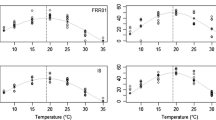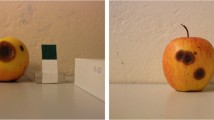Abstract
Several factors influencing the occurrence and extent of external fruit rot caused byDidymella bryoniae on cucumbers in the post harvest period were studied.
The minimum, optimum and maximum temperatures for growth of the fungus on fruits were circa 10, 23 and 35°C, respectively. The influence of the temperature on the growth of the fungus in vitro and in vivo was about similar. The fitness of the fungus diminished by storing inoculated fruits at about the maximum temperature for growth of the fungus for one day, but this temperature influenced fruit quality negatively. Storing at 10 to 12°C is more advisable.
Isolates ofD. bryoniae showed variation in virulence. There was a linear relationship between growth on fruits and growth in vitro of these isolates, but no correlation was found with disease incidence on plants.
The degree of fruit rot was increased by more severe wounding, by storing in the dark instead of in the light and by higher nitrogen fertilization of the crop. Relative humidity during storage had no effect on fruit decay. It is very likely that the amount and composition of available nutrients for fungus growth determine the degree of rotting of the fruits.
With the present cultivars, external fruit rot can be best controlled by reducing the changes of wounding in the pre- and post-harvest period.
Samenvatting
Verschillende factoren die van invloed kunnen zijn op het ontstaan en de mate van uitwendig vruchtrot op komkommers in de periode na de oogst, veroorzaakt doorDidymella bryoniae, zijn onderzocht.
De minimum, optimum en maximum temperatuur voor de groei van de schimmel op vruchten waren respectievelijk circa 10, 23 en 35°C. De invloed van de temperatuur op de groei van de schimmel in vitro en in vivo was nagenoeg gelijk. Door geïnoculeerde vruchten een dag bij de maximum temperatuur voor de groei van de schimmel te bewaren, werd de groeikracht van de schimmel verminderd, maar de vruchtkwaliteit werd door deze temperatuur negatief beïnvloed. Het is raadzamer de vruchten bij 10–12°C te bewaren.
Isolaten vanD. bryoniae vertoonden een variatie in virulentie. Tussen de groei van deze isolaten op vruchten en de groei in vitro bleek een lineair verband te bestaan, maar er bestond geen verband met de aantasting van planten.
De mate van vruchtrot nam toe door de vruchten ernstiger te verwonden, ze in het donker in plaats van in het licht te bewaren en door een hogere stikstofbemesting tijdens de teelt. De relatieve luchtvochtigheid tijdens de bewaarperiode had geen effect op de vruchtaantasting. De hoeveelheden en de samenstelling van de voor de groei van de schimmel beschikbare voedingsstoffen bepalen zeer waarschijnlijk de mate van vruchtrot.
Uitwendig vruchtrot kan bij de huidige cultivars nog het best worden tegengegaan door de mogelijkheden van verwonding, zowel in de periode voor als na de oogst, te verkleinen.
Similar content being viewed by others
References
Ceponis, M.J. & Butterfield, J.E., 1974. Market losses in Florida cucumbers and bell peppers in metropolitan New York. Plant Dis. Reptr 58: 558–560.
Chiu, W.F. & Walker, J.C., 1949. Physiology and pathogenicity of the cucurbit black rot fungus. J. agric. Res. 78: 589–615.
Luepschen, N.S., 1961. The development ofMycosphaerella black rot andPellicularia rolfsii rot of watermelons at various temperatures. Plant Dis. Reptr 45: 557–559.
Saito, M., 1976. Diseases of vegetable fruits occurring during storage and transport and their control. Japan Pesticide Information 26: 5–8.
Steekelenburg, N.A.M. van, 1978. Chemical control ofDidymella bryoniae in cucumbers. Neth. J. Pl. Path. 84: 27–34.
Steekelenburg, N.A.M. van, 1981. Comparison of inoculation methods withDidymella bryoniae onCucumis sativus. Euphytica 30: 515–520.
Steekelenburg, N.A.M. van & Vooren, J. van de, 1981. Influence of the glasshouse climate on development of diseases in a cucumber crop with special reference to stem and fruit rot caused byDidymella bryoniae. Acta Hort. 118: 45–56.
Svedelius, G. & Unestam, T., 1978. Experimental factors favouring infection of attached cucumber leaves byDidymella bryoniae. Trans. Br. mycol. Soc. 71: 89–97.
Wiant, J.S., 1945.Mycosphaerella black rot of cucurbits. J. agric. Res. 71: 193–213.
Author information
Authors and Affiliations
Rights and permissions
About this article
Cite this article
Van Steekelenburg, N.A.M. Factors influencing external fruit rot of cucumber caused by Didymella bryoniae. Netherlands Journal of Plant Pathology 88, 47–56 (1982). https://doi.org/10.1007/BF01977338
Accepted:
Issue Date:
DOI: https://doi.org/10.1007/BF01977338




